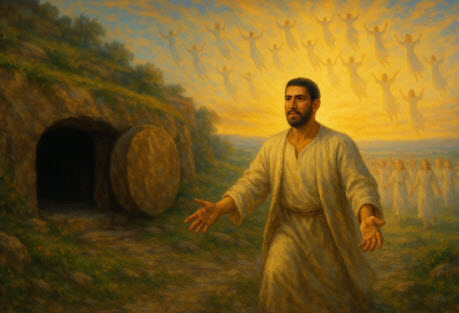The bodily resurrection refers to the literal, physical rising of a person from the dead to a glorified, imperishable life. Central to Christian doctrine is the bodily resurrection of Jesus Christ three days after His crucifixion, which serves as the firstfruits and guarantee of the future resurrection of all who are united to Him by faith. This resurrection is not symbolic or spiritual alone—it involves the transformation of the body itself into a glorified state. It affirms both the defeat of death and the hope of eternal life in physical, glorified bodies for believers.
Scriptural Support
The doctrine of the bodily resurrection is grounded in both the Old and New Testaments:
- Jesus’ Resurrection:
- Luke 24:39 – “See my hands and my feet, that it is I myself. Touch me, and see. For a spirit does not have flesh and bones as you see that I have.”
- 1 Corinthians 15:3–4 – Paul affirms the gospel: Christ died for our sins, was buried, and “was raised on the third day in accordance with the Scriptures.”
- Acts 2:31 – “He foresaw and spoke about the resurrection of the Christ, that he was not abandoned to Hades, nor did his flesh see corruption.”
- Believer’s Resurrection:
- Romans 6:5 – “For if we have been united with him in a death like his, we shall certainly be united with him in a resurrection like his.”
- 1 Corinthians 15:20–23 – Christ is the “firstfruits” of those who have fallen asleep.
- Philippians 3:20–21 – Christ “will transform our lowly body to be like his glorious body.”
- Old Testament Witness:
- Daniel 12:2 – “And many of those who sleep in the dust of the earth shall awake…”
- Job 19:25–26 – “Yet in my flesh I shall see God.”
Historical Development
The doctrine of the resurrection was affirmed by the early church and has remained a cornerstone of Christian orthodoxy. From the Apostles’ Creed (“I believe in the resurrection of the body…”) to the Nicene Creed (“We look for the resurrection of the dead”), the bodily resurrection has been a non-negotiable truth.
- Early Church Fathers: Ignatius of Antioch, Irenaeus, and Tertullian all affirmed a bodily resurrection against Gnostic and docetic heresies that denied the goodness of the physical body.
- Reformation: Reformers like Martin Luther and John Calvin defended the resurrection as essential to the gospel, reaffirming the believer’s hope in a future bodily renewal.
- Modern Challenges: Liberal theology, influenced by naturalism, has often denied or allegorized the resurrection, but evangelical and reformed theology continues to uphold its literal truth as vital.
Theological Significance
The bodily resurrection is not an optional theological add-on—it is central to the Christian faith for several reasons:
- Christ’s Resurrection Validates His Deity and Mission: It proves He is who He claimed to be (Romans 1:4).
- Christ’s Resurrection is the Guarantee of Ours: Believers are united to Christ in His death and resurrection (Romans 6:5, Colossians 3:1).
- Affirms the Goodness of Creation: God intends to redeem the whole person—body and soul—not just disembodied spirits.
- Provides Hope and Motivation for Perseverance: The resurrection gives meaning to suffering and hope for the future (1 Corinthians 15:58).
Practical Implications
- Hope in Death: Christians grieve differently because death is not the end (1 Thessalonians 4:13–14).
- Stewardship of the Body: Since our bodies will be raised, they matter now. Holiness in bodily conduct is emphasized (1 Corinthians 6:13–20).
- Perseverance in Suffering: Resurrection hope gives strength to endure persecution, illness, and hardship, knowing that these bodies will one day be glorified.
- Mission and Evangelism: The resurrection is proof that God’s justice and mercy are real. It compels the church to proclaim the gospel.
Errors and Heresies
Several false teachings have attacked the doctrine of the bodily resurrection:
- Docetism: Claimed Jesus only appeared to have a body and therefore wasn’t truly resurrected.
- Gnosticism: Viewed the body as evil and denied bodily resurrection altogether.
- Sadducees: Rejected the idea of resurrection (Matthew 22:23).
- Liberal Theology: Often reduces the resurrection to a metaphor for renewal or moral inspiration.
- Jehovah’s Witnesses: Deny that Jesus’ resurrection was bodily, asserting it was purely spiritual.
- Hyper-Preterism: Asserts that the resurrection already happened in AD 70 and denies a future bodily resurrection.
The biblical doctrine is clear: Jesus rose bodily, and so shall we.
Cultural Counterfeits
Modern culture often promotes disembodied spirituality, reincarnation, or annihilation after death. New Age movements teach the soul’s progression through different life forms, while materialistic atheism teaches that death is the end. Popular media tends to either spiritualize resurrection (as a ghostly return) or mock it entirely. Even some progressive “Christian” circles reduce resurrection to personal growth or social change.
The biblical view stands in stark contrast: a bodily, eternal resurrection into glory or judgment (John 5:28–29).
Personal Application
- Faith in Union with Christ: The believer’s confidence is not in personal worthiness but in being united to Christ. His resurrection is our resurrection.
- Comfort in Bereavement: Resurrection hope changes how we view funerals, aging, and bodily decay.
- Encouragement in Sanctification: The future glorification of the body encourages present obedience and holiness, anticipating the day when we will be like Christ (1 John 3:2–3).
- Boldness in Witness: The resurrection gives us courage to speak the truth in a world that denies eternal accountability.
Christian Holiday Connections
- Easter (Resurrection Sunday): The chief celebration of the bodily resurrection of Jesus Christ. It affirms victory over sin, death, and the grave. The traditional Easter greeting—”Christ is risen!” with the response, “He is risen indeed!”—rejoices in the historical and bodily resurrection of the Lord.
- Ascension Day and Pentecost also affirm that the risen Jesus continues to reign bodily and sends the Spirit to apply His resurrection life to believers.
Hymns and Worship Songs
- Traditional Hymns:
- Christ the Lord Is Risen Today – Charles Wesley
- Low in the Grave He Lay (a.k.a. Up from the Grave He Arose)
- I Know That My Redeemer Lives
- Contemporary Songs:
- Risen – Vertical Worship
- Resurrecting – Elevation Worship
- Living Hope – Phil Wickham
- Because He Lives (Amen) – Matt Maher
- Glorious Day (Living He Loved Me) – Casting Crowns
- Forever – Kari Jobe
- He Lives – Chris Tomlin
- King of Glory – Third Day
These songs exalt the risen Christ and declare our hope of sharing in His resurrection.
This doctrinal explanation on the resurrection of Christ and believers is one of a series that I am developing to explain essential (core) doctrines of the Christian faith.
S.D.G.,
Robert Sparkman
rob@christiannewsjunkie.com
RELATED CONTENT
Concerning the Related Content section, I encourage everyone to evaluate the content carefully.
Some sources of information may reflect a libertarian and/or atheistic perspective. I may not agree with all of their opinions, but they offer some worthwhile comments on the topic under discussion.
Additionally, language used in the videos may be coarse. Coarse language does not reflect my personal standards.
Finally, those on the left often criticize my sources of information, which are primarily conservative and/or Christian. Truth is truth, regardless of how we feel about it. Leftists are largely led by their emotion rather than facts. It is no small wonder that they would criticize the sources that I provide. And, ultimately, my wordview is governed by Scripture. Many of my critics are not biblical Christians.
Feel free to offer your comments below. Respectful comments without expletives and personal attacks will be posted and I will respond to them.
Comments are closed after sixty days due to spamming issues from internet bots. You can always send me an email at rob@christiannewsjunkie.com if you want to comment on something, though.
I will continue to add items to the Related Content section as opportunities present themselves.

